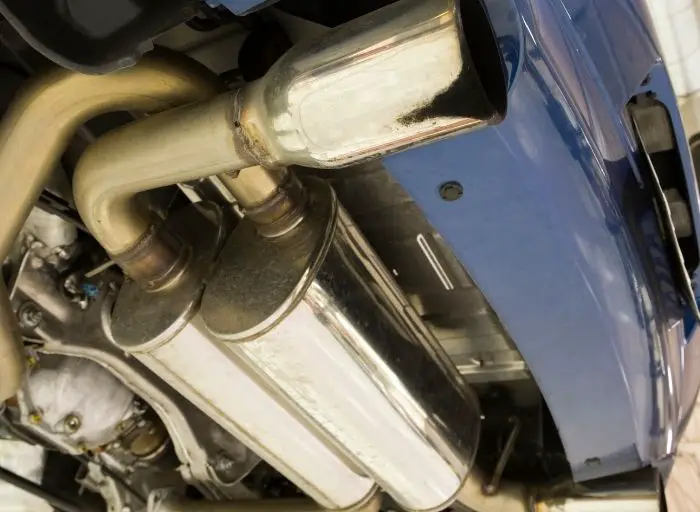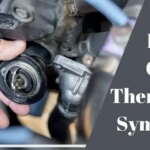
If a loud turbo is your fave, then knowing the differences between straight pipe vs downpipe is crucial for a better decision. In this blog, you’ll know what these 2 pipes are and how they differ.
Simply stated, straight pipes are louder than downpipes. Straight pipes will require you to replace the exhaust more frequently than your car’s engine, while downpipes are easier on the wallet and for the wrenching. Downpipes will also be easier on fuel consumption because they offer a cleaner ride, while straight pipes are only about the power.
Table of Contents
What is a downpipe?
A downpipe is a pipe that transfers exhaust from the exhaust manifold to the turbo. A downpipe can either be made of stainless steel or carbon fiber alloy, but most are made of the latter. A solid design helps to enhance performance because it does not heat up like a free-flowing system.
Every bolt and nut on an exhaust system provides an entrance for heat to escape from the engine, which can cause your car to overheat; thus making it more prone to engine damage when racing.
Downpipes are usually made from stainless steel or high temperature alloy metals like titanium or inconel due to their superior strength and heat resistance. These metals also provide corrosion resistance and good thermal characteristics, which means they won’t break down over time due to exposure to extreme temperatures. To further increase strength and durability, some manufacturers may include a flex section in the middle of the pipe, allowing it to move slightly as the vehicle moves.
Pros and cons of downpipes
Advantages of downpipe:
- Increased horsepower
- Improved turbo spool
Disadvantages of downpipe:
- More expensive
- Complex installation
Types of downpipe
There are 2 types of downpipe systems: catless and high-flow catted. Both are made up of a downpipe and midpipe combination. The catless system will not feature a catalytic converter, while the high-flow catted system will have an external catalytic converter.
Catless downpipes
Catless downpipes are the most commonly used type, as they are the simplest and least expensive option. They are basically just pipes that connect the exhaust manifold to the rest of the exhaust system, without any sort of catalytic converter. This means that catless downpipes generally do not reduce emissions, but they do provide a performance boost by reducing backpressure and allowing for a freer flow of exhaust gases.
High-flow catalytic converter downpipes
High-flow catalytic converter downpipes contain a catalytic converter that helps reduce pollutant emissions. The catalyst inside the converter works to break down toxic gases such as nitrogen monoxide into less harmful gases like nitrogen dioxide and water vapor. High-flow catalytic converter downpipes also help improve engine performance, though typically not as much as catless models due to the additional weight from the converter.
How do downpipes work?
A down pipe exhaust works by reducing the exhaust gas pressure coming from an engine and carrying it away from the car. This is done by allowing the exhaust gases to exit at a lower pressure than they enter, allowing them to flow more quickly and efficiently.
The system consists of various pipes and components like the manifold, catalytic converter, silencer, downpipe, tailpipe and exhaust tip.
The downpipe is located in between the manifold and catalytic converter, and its main purpose is to reduce backpressure in order to maximize power output. By being larger in diameter than other components of the exhaust system, it allows for a greater volume of gas to pass through smoothly with less restriction.
The downpipe also helps to lower emissions by directing those pollutants away from the vehicle, as well as keeping noise levels down which makes for a more pleasant driving experience.
What is a straight pipe?
A straight pipe is the same as a stock exhaust but without the catalytic converter and muffler. A practical straight pipe will be much lighter and allow you to feel every bit of your exhaust note’s vibration through your car’s interior. A straight pipe will also add to your car’s performance because it allows you to feel more power through the gearbox, clutch, and driveline.
The pros and cons of straight pipes
Advantages of straight pipe:
- Increased horsepower
- Reduced back pressure
Disadvantages of straight pipe:
- Loud noise
- Legal issues
For straight pipe exhaust pros cons details, you can check out this article.
Types of straight pipe
Types of straight pipes in vehicles include axle-back, cat-back, and header-back exhaust systems.
Axle-back exhausts are typically found on mainstream cars and SUVs, as they are a relatively simple setup of two straight pipes from the catalytic converter to the back of the car.
Cat-back exhausts typically feature larger piping than axle-backs and offer improved performance. It starts at the catalytic converter and runs between the rear axle and bumper.
Header-back systems replace all of the factory piping with larger diameter tubing that offers much better flow than stock piping. They also feature an X or H pipe to balance out sound coming from each side of the motor, helping to create a more balanced tone.
All three types of straight pipes are designed to improve engine breathing while also giving cars a more aggressive look and sound.
How does a straight pipe exhaust work?
A straight pipe exhaust is a type of vehicle exhaust system that works by allowing the exhaust gases from an engine to travel through a single, straight section of pipe.
This pipe typically consists of steel tubing which has been bent in such a way that it follows the contours of the engine compartment and leaves at the back end of the car.
This type of exhaust system works by utilizing the natural force created by the pressure changes that occur when different amounts of gas flow through the same cross-sectional area. When this pressure change is solidified, it creates a vacuum that pulls the exhaust gases out through the tailpipe in an efficient manner with minimal backpressure on the engine itself.
Since there is only one pipe and no additional bends or curves present, there are fewer places for blockages or clogs to form which can help improve performance.
Straight Pipe vs Downpipe: A Detailed Comparison
When it comes to choosing between a straight pipe and a downpipe, there are several factors to consider in terms of performance gains, sound levels, cost, legal issues, and installation.

Performance
In terms of horsepower gains, running a straight pipe can yield up to 8% more power than a downpipe when optimized. This is due to the increased amount of exhaust flow that occurs with the lack of back pressure caused by a downpipe.
Also, torque gains can also be higher with a straight pipe setup due to its open design allowing for maximum exhaust flow.
Noise level
There are a lot of differences between downpipes and straight pipes, but the main difference is the fact that straight pipes will make your car louder. The reason is that the exhaust travels through a straight pipe and does not have to travel around your catalysts, which are located at the midpipe.
In contrast, downpipes will have to go through the catalysts before entering the turbo, which means that there is more resistance in the path of the exhaust gases. As a result, there will be less noise generated from these gases as they enter your catalysts.
Investment & maintenance cost
Another difference is that straight pipes don’t have to be replaced as often as a downpipe, so you will pay less money on exhaust parts. However, you need to spend more on downpipe at first.
Generally speaking, aftermarket downpipes tend to be significantly more expensive than straight pipes due to their custom fabrication requirements as well as their better quality materials used that can withstand greater temperatures and pressure than those found in standard exhaust systems.
To install a straight pipe exhaust, you are expected to spend from $1000 to 1500. Whereas, you need to spend more on a downpipe system, which can cost between $2000 and $2500.
Car’s emissions
Downpipes also offer a cleaner and more efficient way of breathing for your engine which makes it easier on gas. As it contains catalytic converters, downpipes will work to decrease your car’s emissions.
Legal issues should also be taken into account when comparing straight pipes versus downpipes; certain modifications may not pass emissions tests or local noise restrictions so make sure you check your local laws before making any changes to your vehicle’s exhaust system.
Variety
Finally, if you’re looking for something other than straight pipes, then a downpipe is the way to go. You can find a variety of downpipes from manufacturers all over the world.
Factors to Consider when Choosing between Straight Pipe and Downpipe
When choosing between a straight pipe and downpipe, there are several factors to consider.
Driving style
One of the most important is driving style. If you drive frequently in traffic or on highways, a downpipe may be best as it provides smoother acceleration and faster spool-up times. On the other hand, if you’re looking for maximum power and response, then a straight pipe is better as it offers less backpressure and more horsepower.
Legal issues
Legal restrictions should also be taken into account when making your decision. Many cities have noise ordinances which limit the maximum volume of vehicles on public roads. In this case, a downpipe would be the wiser choice since it allows for more sound control than a straight pipe does. It’s also important to make sure that the vehicle meets any applicable emissions standards when selecting an exhaust system.
Budget
Budget is another major factor to consider when choosing between a straight pipe and downpipe. Straight pipes tend to be cheaper than downpipes since they require less material and labor during installation. However, in some cases, a downpipe may provide greater value due to its improved performance characteristics.
Maintenance
Maintenance must also be kept in mind when selecting an exhaust system; both types will require regular cleaning and inspection of all components to ensure they are functioning properly. Additionally, replacement parts may need to be purchased periodically, depending on how frequently the vehicle is driven.
Sound preference
Lastly, sound preferences must also be considered when deciding between straight pipes and downpipes. Downpipes allow for quieter operation, whereas straight pipes provide louder engine noises that can add character to your vehicle’s performance soundscape. Ultimately, it’s up to you to decide which type suits your needs best.
FAQs
#1 Is straight pipe illegal?
Straight-pipe exhaust systems are illegal in most areas due to their excessive noise and air pollution.
This type of system bypasses the catalytic converter, which is designed to reduce pollutants released into the atmosphere.
Moreover, straight pipes lack sound-deadening materials that reduce exhaust noise and make them louder than permissible levels.
Because of these factors, straight pipe exhausts violate local and federal regulations as they contribute to noise pollution and air quality issues. Furthermore, some states have implemented specific laws banning this type of system outright or requiring additional measures such as mufflers or other sound-mitigating components.
#2 What is the legal limit for noise level?
The Environmental Protection Agency (EPA) regulates exhaust noise levels for all vehicles on public roads. For passenger cars, the legal limit is 95 decibels, and for trucks, it is 106 decibels. If a vehicle’s exhaust system exceeds these limits, local law enforcement can issue citations or penalties.
Additionally, many states have additional laws that further regulate noise levels, such as California’s decibel limit of 88 for passenger cars and 98 for trucks. It is important to be aware of the local laws in your area before installing a new exhaust system. Failure to comply can result in fines or other legal action.
#3 Can I pass emissions with a straight pipe?
In most states, the answer to this question is no. A straight pipe system does not have any type of muffling device, which means it can produce noise levels that exceed legal limits. Besides, without a catalytic converter or other emission control device, there will be higher levels of pollutants in the exhaust gases, resulting in an automatic fail on emissions testing. Therefore, if you live in an area where emissions testing is required, then a straight pipe system is not an option.
However, some states do allow for the use of certain types of mufflers or catalytic converters that can still produce a loud noise while passing emission tests. It is important to check with your local laws before installing a straight pipe system.
#4 Can I install a downpipe without a tune?
No, a tune is essential if you are installing a downpipe. Even if the engine is not turbocharged, removing the catalytic converter will cause an imbalance in backpressure and can lead to your car running leaner than it should. A tune will help adjust the air/fuel ratio for optimal performance and keep your engine running safely.
#5 Which is better for daily driving, straight pipe or downpipe?

When it comes to daily driving, the better option is a downpipe. Downpipes contain a catalytic converter, which helps reduce emissions and improve fuel efficiency. Additionally, the smooth bends and larger diameter of a downpipe can result in improved horsepower gains when compared to that of straight pipes.
On top of that, the sound emitted from a properly designed downpipe will be more refined and less harsh than that of a straight pipe. Ultimately, the downpipe sacrifices some potential performance gains for increased comfort and convenience during daily driving.
#6 Do cars come with a downpipe?
Downpipes are not typically included when purchasing a car. Downpipes are a component of an exhaust system, and they typically must be purchased separately. The downpipe connects the catalytic converter to the muffler, allowing exhaust gases to pass through more efficiently.
It is possible to purchase a downpipe aftermarket and install it in your vehicle as an upgrade or to replace an existing part that has become faulty. To install a downpipe properly, you will need some welding skills or access to someone who can do the installation for you.
Check how this guy passed the emission test with straight pipe:
Conclusion
Downpipes are the most popular choice for turbo cars because they offer a cleaner engine and improved performance. Straight pipes may be cheaper and louder, but the benefits don’t outweigh their drawbacks. Nonetheless, if you plan on doing extreme racing, it is probably best that you opt for a straight pipe system just so you can feel the turbo’s power on tap.
Further reading:
Hi there! I’m Naomi O’Colman. I’ve got years of experience working at an auto repair shop here in Texas under my belt. On top of that, ever since I was a kid I’ve been passionate about the auto industry. Since I’ve joined the team at automotivegearz.com I’ve been enthusiastically sharing my passion and insights with my readers. I’m dedicated to delivering high quality content and helping you stay up to date with the latest automotive trends and products out there!







